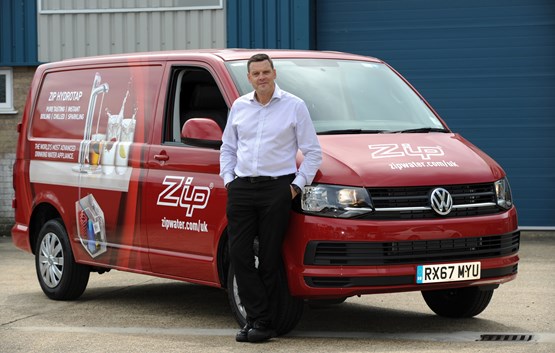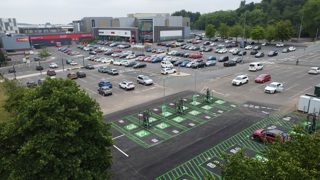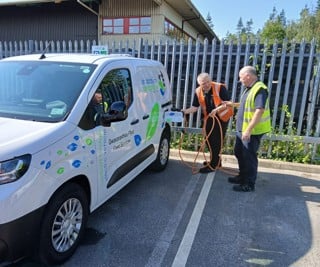The first thing Graham Short (pictured) did when he was appointed fleet manager at Zip Water was to cancel an order for two Mitsubishi Outlander PHEVs.
There was nothing wrong with the vehicles – in fact Zip Water has three others on its fleet – but Short identified that “they were not going to be used in the right way”.
The drivers had chosen them simply for the benefit-in-kind (BIK) tax savings and had not considered the fact they would be driving 30,000 miles a year, mostly on motorways, so the vehicles would mainly be running on petrol, negating the benefit of having a plug-in hybrid vehicle and potentially costing the business a fortune in fuel.
So how did the drivers take the news?
“Clearly they were disappointed they were not going to have the tax break they thought they were going to have but I explained my reasons for doing it and I was supported from the top,” Short says.
In both instances the drivers went into economical, low CO2 diesel cars instead of the Outlander PHEVs.
However, where appropriate, Short does encourage the use of electric and hybrid vehicles.
Earlier this year he persuaded a company car driver who travels into London most days to swap his diesel Audi A4 for a Volkswagen Golf GTE, which means the company no longer has to pay the congestion charge.
“Ideally he would use public transport, but he needs to carry sales brochures and samples in it every day,” Short says. “It’s the right car in the right application.”
Zip Water has four plug-in cars on its fleet of 53 cars and 69 vans, earning it Go Ultra Low company status (the Government-led campaign which recognises UK businesses that are embracing electric vehicles).
It has fitted home charging units to support the use of electric vehicles and Short is now considering installing a charging point at the company’s Dereham office in Norfolk, where he is based, and adding an electric pool car to the fleet.
Leasing broker Fleetdrive Electric will also assist Short with a driver survey to identify individual mileages and whether a driver’s job need would suit an electric vehicle.
However, introducing electric vans is not currently feasible as public charging infrastructure is not adequate in Short’s opinion.
“We’ve trialled the Nissan e-NV200 in four different applications because we’re heavily involved in the London area – about a third of our fleet goes into London on a daily basis – but we’ve struggled with infrastructure,” Short says.
“The first electric van we trialled we ended up letting down some of our customers because the driver had got to the fourth charging point before he found one that was working.”
Short acknowledges this was about a year ago and the infrastructure may be better now but he doesn’t yet have the confidence to add an electric van to the fleet.
“The challenge we have is all of our engineers are based from home and if we could install a charging point in an engineer’s home then we would. But they tend to live in tower blocks so it’s not feasible to do that,” he says.
It is also not possible to install a charging point at the company’s Farringdon office in London as there are no parking facilities.
With the current congestion charge, the introduction of the £10 emissions surcharge (T-charge) in central London this October and the forthcoming Ultra-Low Emission Zone (ULEZ), Short understands the financial, as well as the environmental, need to run low emitting vehicles.
He already has 21 Euro 6 vans on the fleet with a further five due to be added in September.
“We’re doing our best to operate the cleanest vans we can,” he says.
“So many fleets like mine would like to do so much more but we have to try and get manufacturers and councils to meet us halfway and support us with some infrastructure.”
As an alternative, Zip Water encourages public transport use, where possible.
“We’ve currently got an engineer on foot because it’s more practical to do that.
So we can have parts delivered to a site and the engineer will travel there using public transport,” Short says.

Although the use of electric vans is an on-going challenge, there are many other changes which Short has successfully made since joining Zip Water in December 2015.
Previously the fleet was run by the technical training manager but due to the business and fleet growing, Zip Water decided to recruit an experienced fleet manager.
Short saw it as an opportunity to be involved with a fleet that “almost had a blank canvas”.
He inherited a “very mixed fleet” as the company car policy had no restrictions on manufacturer or CO2 emissions, despite the majority of cars being job-need rather than perk as they are used by business development managers.
“We’ve streamlined it and we just have a choice of Audi, Volkswagen, BMW or Volvo,” Short says.
He also introduced a CO2 cap of 120g/km, which he is in the process of reviewing with a view to lowering it.
The van fleet is all Volkswagen, mirroring the policy of Zip Water’s parent company in Australia.
“We’ve got a very good relationship with VW,” Short says. “I look upon our supplying dealer, the Cordwallis Group, as a partner rather than a supplier because they work very well with us to move vehicles when we have new vans coming in and old vans going out.
“They also have mobile workshops so because we have a large number of vans in and around the London area, which is where they are based, they can support us with out-of-hours servicing and running repairs so that reduces our downtime.
“The general lead time for booking in any sort of work in a workshop can be a week to two weeks, whereas the mobile workshops can quite often tend to us the next day if we have a running repair, a broken mirror or something that needs to be done.
"We even get the workshop mobile mechanics to meet our drivers on a site if it’s appropriate.”
The vans are all leased on four-year/120,000-mile contracts, while cars are leased for three years/90,000 miles.
“The main reason we lease is because it’s more cost-effective,” Short says. “We’ve gone through a process of comparing outright purchase with contract hire and there is a time value of money involved which swings us towards contract hire.
“But also it’s very uncertain times so I don’t think we would want to invest a great deal of money in a specific vehicle not knowing what it was going to be worth in two or three years, whether that be a diesel engine vehicle or an electric one.
“Leasing doesn’t give us that risk and it gives us flexibility so we can tailor our contracts.
"If we want to only lease the vehicle for a year or two we have the flexibility to do that.”
LeasePlan is Zip Water’s main funding provider but Short recently began using Marshall Leasing too due to its flexibility and to benchmark contract hire quotes.
Currently, just under a fifth of the fleet (23 vehicles) is leased from Marshall.
Short acknowledges that for administrative purposes it would be easier to manage one provider but the process is made simpler by using fleet management software from FleetCheck – something which Short introduced not long after joining Zip Water as the fleet was previously run on a spreadsheet.

Fleet management software is also essential because Short’s time is split between fleet, health and safety and facilities.
He advises any fleet manager juggling two or three roles to take advantage of any help that is on offer from suppliers, too.
“A lot of the admin burden can be taken up by a leasing provider, for example,” he says.
Choosing the right supplier is not simply about price for Short.
Last year he changed from Keyfuels to Shell because Shell offered the best overall package.
“It works really well for us because the locations are good, the pricing is consistent, the reports are very good, security is good and it integrates with our fleet management software,” he says.
Zip Water also allows drivers to use the fuel cards at the Shell station car washes.
“We do try to emphasise that they need to keep their vehicles clean, particularly the vans, because they are an advert for us,” Short says. “Your vans are either your best or your worst advert.”
All of Zip Water’s vans are now speed limited to 70mph and the entire fleet uses TomTom telematics, with car drivers making use of the app to submit mileage claims (see page 37).
Drivers previously had ‘free’ private fuel but Short was able to demonstrate that in a lot of cases they were better off without it.
“Once you communicate it in the right way and explain that they are probably being taxed £2,000 for £1,000 worth of fuel, for example, it’s quite easy to get them to buy into that,” he says.
Telematics had just been installed when Short joined Zip but the system wasn’t being fully utilised.
“I’m using it to give drivers feedback on their driving performance,” he says.
“Each driver gets a report at the start of every month for his or her driving performance for the previous month and as part of the employee’s performance review, and our emphasis on health and safety, driving performance becomes part of an employee’s overall performance.
“There is a financial objective attached to it so it’s in the driver’s interest to improve on the previous month, it’s up to them to self-manage and pretty much, without exception, they do. If you treat them like adults and give them a responsibility they’ll respond in the right way.”
Short has also raised awareness of the ‘true’ cost of an accident through a joint presentation with his insurer at the company’s service engineer conference.
“Everyone has bought into it and understands and we’ve seen our at-fault accidents more than halve (from 54 in 2014/15 to 22 this year),” says Short.
Last year Zip Water secured a 15% reduction in its insurance premium and Short is hopeful of a further reduction at renewal in September, based on the fleet’s performance over the past 12 months.
“I’ve been able to identify a couple of drivers who were repeat offenders in terms of crashes and we’ve implemented a driver education programme for them,” he says.
“We have a trainer, who is recommended by our insurer, and he spends an appropriate amount of time understanding why the driver is crashing and then taking steps to put that right.
“It’s only been small numbers but we have seen the driving events recorded by the telematics system go in the right direction as a result.”
The fleet’s latest Transporters have autonomous emergency braking (AEB) as standard and Short is also planning to fit cameras as and when vans are due for replacement.
“The van will have an interior mirror fitted but the interior mirror becomes a screen for when the driver selects reverse so he can see what’s going on behind him but it’s also forward-facing with recording facilities,” he says.
If it’s successful, Short will look to fit a similar device to the car fleet.
The fleet has grown 10% since Short was appointed and he envisages further growth as the company is recruiting additional service engineers and business development managers.
Whether they will be in electric vehicles remains to be seen.
“I will try to add more electric vehicles when the time is right,” Short says. “That’s my big desire.”



















Jim - 16/09/2017 12:26
Great article. Lots of valuable examples.